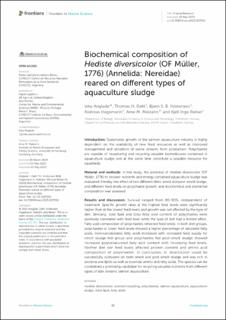| dc.contributor.author | Anglade, Inka | |
| dc.contributor.author | Dahl, Thomas | |
| dc.contributor.author | Kristensen, Bjørn | |
| dc.contributor.author | Hagemann, Andreas | |
| dc.contributor.author | Malzahn, Arne | |
| dc.contributor.author | Reitan, Kjell Inge | |
| dc.date.accessioned | 2023-12-07T14:21:06Z | |
| dc.date.available | 2023-12-07T14:21:06Z | |
| dc.date.created | 2023-06-15T17:23:50Z | |
| dc.date.issued | 2023 | |
| dc.identifier.citation | Frontiers in Marine Science. 2023, 10. | en_US |
| dc.identifier.issn | 2296-7745 | |
| dc.identifier.uri | https://hdl.handle.net/11250/3106476 | |
| dc.description.abstract | Introduction: Sustainable growth of the salmon aquaculture industry is highly dependent on the availability of new feed resources as well as improved management and utilization of waste streams from production. Polychaetes are capable of recapturing and recycling valuable biomolecules contained in aquaculture sludge and at the same time constitute a possible resource for aquafeeds. | en_US |
| dc.description.abstract | Material and methods: In this study, the potential of Hediste diversicolor (OF Müller, 1776) to recover nutrients and energy contained aquaculture sludge was evaluated. Hereby, the effect of two different diets, smolt and post-smolt sludge, and different feed levels on polychaete growth, and biochemical and elemental composition was assessed. | en_US |
| dc.description.abstract | Results and discussion: Survival ranged from 80-90%, independent of treatment. Specific growth rates at the highest feed levels were significantly higher than at the lowest feed levels and growth was not affected by the type of diet. Similarly, total lipid and total fatty acid content of polychaetes were positively correlated with feed level while the type of diet had a limited effect. Fatty acid composition of polychaetes reflected feed levels: in both diet groups, polychaetes at lower feed levels showed a higher percentage of saturated fatty acids; monounsaturated fatty acids increased with increased feed supply for smolt sludge-fed group and polychaetes fed post-smolt sludge showed increased polyunsaturated fatty acid content with increasing feed levels. Neither diet nor feed levels affected protein content and amino acid composition of polychaetes. In conclusion, H. diversicolor could be successfully cultivated on both smolt and post-smolt sludge and was rich in proteins and lipids as well as essential amino and fatty acids. The species can be considered a promising candidate for recycling valuable nutrients from different types of side streams salmon aquaculture. | en_US |
| dc.language.iso | eng | en_US |
| dc.publisher | Frontiers | en_US |
| dc.rights | Navngivelse 4.0 Internasjonal | * |
| dc.rights.uri | http://creativecommons.org/licenses/by/4.0/deed.no | * |
| dc.title | Biochemical composition of Hediste diversicolor (OF Müller, 1776) (Annelida: Nereidae) reared on different types of aquaculture sludge | en_US |
| dc.title.alternative | Biochemical composition of Hediste diversicolor (OF Müller, 1776) (Annelida: Nereidae) reared on different types of aquaculture sludge | en_US |
| dc.type | Peer reviewed | en_US |
| dc.type | Journal article | en_US |
| dc.description.version | publishedVersion | en_US |
| dc.rights.holder | © 2023 Anglade, Dahl, Kristensen, Hagemann, Malzahn and Reitan. Distributed under the terms of the Creative Commons Attribution License (CC BY). | en_US |
| dc.source.pagenumber | 12 | en_US |
| dc.source.volume | 10 | en_US |
| dc.source.journal | Frontiers in Marine Science | en_US |
| dc.identifier.doi | 10.3389/fmars.2023.1197052 | |
| dc.identifier.cristin | 2155028 | |
| cristin.ispublished | true | |
| cristin.fulltext | original | |
| cristin.qualitycode | 1 | |

